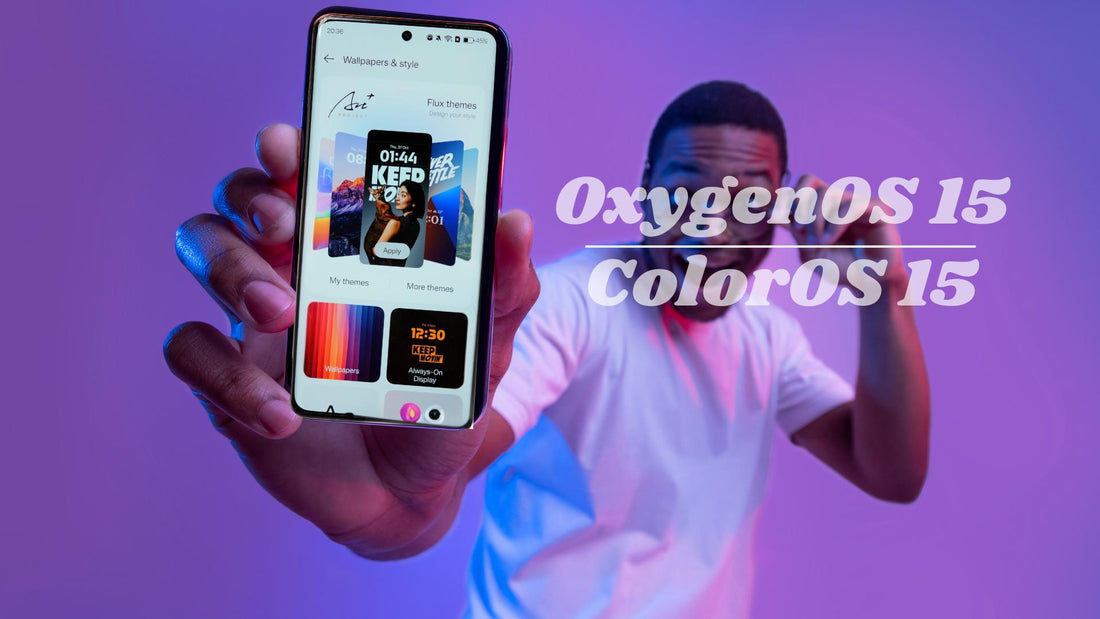
OxygenOS 15 vs ColorOS 15: What's the Difference?
Share
New OnePlus owners might find themselves puzzled by the differences between OxygenOS and ColorOS. These two operating systems power OnePlus devices, including the latest and highly anticipated OnePlus 13. The latest version of the two, which is the 15, rolled out in supported devices in 2024, focusing on new features, improvements, and changes.
The first open beta version of OxygenOS 15 was released on October 30, 2024, for the OnePlus 12 and OnePlus 12R. Meanwhile, ColorOS 15 was released globally in November 2024, with an upgrade plan for January 2025. Many users have already made their impressions of the software, detailing pros and cons based on real-life usage.
In this guide, we’ll break down the key differences between OxygenOS and ColorOS to help you understand what each operating system offers. This detailed comparison of OxygenOS 15 vs ColorOS 15 covers their design, features, performance, and more.
Table of Content
Comparing OxygenOS 15 vs ColorOS 15
OxygenOS and ColorOS are similar in many ways, but there are some key differences. For one, the two software variants share a common foundation. Both are based on Android 15, with the latest versions being ColorOS 15 and OxygenOS 15, respectively, meaning they incorporate the features and updates from the latest Android version on their respective custom interfaces. However, the two are distinguished by their regions, which have unique features and user experiences that cater to different audiences.
Let’s define them individually.
OxygenOS is the global version of OnePlus’s operating system, known for its clean interface and close-to-stock Android experience. The OxygenOS 15 will come pre-installed on the upcoming OnePlus 13 (global version), offering some of the best features of an Android device.
Meanwhile, OnePlus phones sold in mainland China come preinstalled with ColorOS, the Chinese version of OxygenOS (other regions use HydrogenOS). This explains why ColorOS has some regional add-ons, as it's intended for Chinese units. The first devices to receive this update are the Oppo Find N3, Find N3 Flip, and Reno 11 Pro.
The two OS updates mainly differ in design aesthetics, pre-installed applications, and certain functionalities to cater to their respective user bases.
1. User Interface (UI) and Design
OxygenOS 15 is known for its redesigned system icons, including new icons for first-party apps. It uses square icons as the default and has themes like Radiance and Shadow. You can also use custom icon packs. Designed for global users, it offers a clean, near-stock Android experience with more rounded corners and fresh charging animation. The minimalist interface ensures smooth performance, making it ideal for users who prefer a clutter-free look.
On the other hand, ColorOS uses circular icons rather than squares. It has a UI that focuses on natural lighting and shadows to help users navigate in any lighting condition. Tailored for Chinese users, it features a more vibrant and customizable design. With additional animations and a focus on aesthetics, ColorOS provides a more immersive interface.
Here's a clear visual of the OxygenOS 15/ColorOS 15 interfaces:
This animation is damn cool 🔥
— Anir Chakraborty (@encoword) October 26, 2024
ColorOS 15 / OxygenOS 15 pic.twitter.com/yzuhLpCPIN
2. Pre-installed Apps
OxygenOS 15 comes with fewer pre-installed apps, aligning with its streamlined design. Additionally, users have the freedom to customize their app collection without dealing with bloatware.
Meanwhile, ColorOS 15 features a larger suite of pre-installed apps, including region-specific services and tools commonly used in China. ColorOS also has exclusive features like Aquamorphic Sound Effects and the ability to create larger folders.
3. Customization Options
Basic customization options like icon packs, themes, and widgets while staying close to Android’s default layout best describe the OxygenOS 15. Besides those, it also introduced customizable lock screen and home screen styles, allowing users to change clock styles and add depth effects to photos, similar to iOS features. While the interface offers customization options, some lock screen and wallpaper choices are limited and may not appeal to all users.
ColorOS 15 also excels in customization, allowing users to personalize nearly every aspect of their device, from themes to gesture controls. It features optimized animations for responsive app switching.
We're giving this transition a chef's kiss!
OxygenOS 15’s AOD and Lock Screen transitions are lit! 👀🔥 pic.twitter.com/fg8DVwJRTj
— Adan (@durreadan01) November 7, 2024
4. Updates and Support
OxygenOS 15 receives regular global updates, including security patches and feature enhancements, keeping your device up-to-date with the latest Android innovations. Meanwhile, ColorOS 15 provides updates tailored to the Chinese market but may include region-specific features that are not found in the global version.
5. App Store Integration
OxygenOS 15 is integrated with the Google Play Store for seamless app downloads and updates. On the other hand, ColorOS 15 relies on the OPPO App Market, optimized for Chinese apps and services, but lacks native Google Play integration.
6. Performance and Optimization
Both are basically powerful and designed to be smarter, smoother, and faster. If we have to specify their advantages, OxygenOS 15 is more deeply rooted in the OnePlus 13’s upgraded hardware, allowing quicker load times and smoother multitasking. The introduction of Parallel Processing technology on the OxygenOS 15 aims to maintain smooth animations and efficient app switching, which is particularly beneficial for heavy multitaskers.
7. AI Features & Privacy
Most of the AI features in these systems are mostly cloud-based, which could be a major concern for data privacy. However, both ColorOS and OxygenOS have made strides in improving their privacy policies to address user concerns. For example, ColorOS offers a ‘Private Safe’ feature that keeps sensitive data secure on the device, and OxygenOS includes a ‘OnePlus Private Vault’ to ensure that personal data remains private.
Additionally, both systems comply with global privacy regulations, such as GDPR (General Data Protection Regulation) in Europe, which mandates transparency in data collection and processing.
These are some of the popular AI features incorporated in the respective operating systems:
OxygenOS 15
AI Photo-Editing Tools: AI Eraser, AI Detail Boost, AI Reflection Eraser, and AI Unblur
AI Assistant Integration: Google Assistant; Google Gemini
Google Assistant remains the default on the OnePlus 12; however, future devices like the OnePlus 13 are expected to feature Google Gemini as the default assistant.
ColorOS 15
AI Photo-Editing Tools: AI Clarity Enhancer, AI Eraser, AI Unblur and AI Reflection Remover
AI Toolbox (AI Reply, AI Writer, AI Speak, and AI Summary)
ColorOS also has a Smart Charging system that uses AI to set the charging current based on how you use your phone.
8. More Features and Functionality
The easiest way to distinguish the features between OxygenOS and ColorOS is that the former focuses on core Android features, while the latter focuses on region-specific features such as OPPO’s Breeno Smart Assistant and a comprehensive privacy suite tailored for Chinese versions. ColorOS 15 has a gaming mode with many features, including the ability to add game pads.
OxygenOS 15 has a new feature called Zen Mode for focused productivity and efficient multitasking tools. This software also helps keep photos sharp, even when you zoom in on details. Lastly, some mobile gaming experiences on OnePlus 12 running on OxygenOS 15 observe noticeable strengths, though it’s unclear how much of this is due to software optimizations versus hardware capabilities.
Did You Know?
Speaking of functionality, we've confirmed that the OnePlus 13 will not support the Qi2 charging protocol, but it's designed for MagSafe functionality through a compatible OnePlus 13 MagSafe case. We recommend a sleek, ultra-thin case for seamless functionality, such as this best minimalist aramid fiber case:

Can I Switch from ColorOS to OxygenOS and Vice Versa?
Yes, technically, you can switch between ColorOS and OxygenOS. However, it requires advanced technical knowledge and involves unlocking your phone's bootloader, flashing custom ROMs, and potentially voiding your warranty; this process is usually done through custom firmware found on platforms like XDA Developers and is not officially supported by either Oppo (ColorOS) or OnePlus (OxygenOS). Let’s break them down below:
1. Not a simple process
Switching between these operating systems is not a straightforward setting change and requires significant technical expertise.
2. Unlocking bootloader
To flash a different ROM, you need to unlock your phone's bootloader, which often voids the manufacturer's warranty.
3. Custom ROMs
You'll need to download and flash the appropriate custom ROM (either ColorOS or OxygenOS) onto your device.
4. Potential risks
Attempting to change the OS without proper knowledge can lead to issues, including potential device malfunction. Improper flashing can brick your phone, so proceed with caution and thorough research.
For a visual comparison and more insights into the differences between OxygenOS 15 and ColorOS 15, you might find the following video helpful:
Wrap Up
The take on the distinct software experiences OxygenOS 15 and ColorOS 15 offer reflect the needs of their user bases and are largely distinguished by their regions. Additionally, there may be slight differences in design choices, app ecosystems, and how they approach customization and functionality. Nonetheless, with a foundation on Android 15, both have offered a cleaner, near-stock Android experience.
Products Featured In This Blog
Frequently Asked Questions
Is OxygenOS 15 available for older OnePlus models?
No, OxygenOS 15 is not available for older OnePlus models:
- Supported devices The OnePlus 12, OnePlus Open, and OnePlus Pad 2 are expected to be the first to receive the OxygenOS 15 update.
- Budget devices The OnePlus Nord 4, OnePlus Nord CE 4, and OnePlus Nord 4 CE Lite are expected to receive the open beta in December 2024, with the stable version rolling out in early 2025.
- OnePlus 11, 11R, 10R, and 10 Pro These models are expected to receive open beta updates at the end of the year and in early 2025.
- Older devices Older devices are not expected to receive the OxygenOS 15 update.
OnePlus' flagship devices and number series are usually the first to receive the latest updates.
How does ColorOS 15 handle Google apps and services in China?
ColorOS 15 in China does not natively support Google apps due to restrictions. However, you can manually install Google apps via APKs or third-party app stores.
Which operating system is better for gaming?
Both OS versions are optimized for gaming, but ColorOS 15 offers additional features like Game Space and controller support. OxygenOS 15 provides smooth performance with its Parallel Processing technology.
Can I use themes from OxygenOS on ColorOS or vice versa?
Themes are specific to each OS and cannot be directly transferred between OxygenOS and ColorOS without third-party apps or custom ROMs.
Related Readings
Written by Riley
"Crafting content as @RileyWritesTech with a passion for translating complex tech into clear insights."



